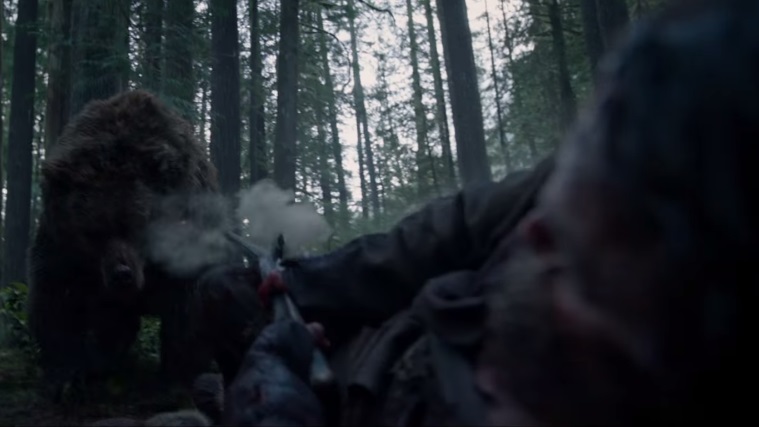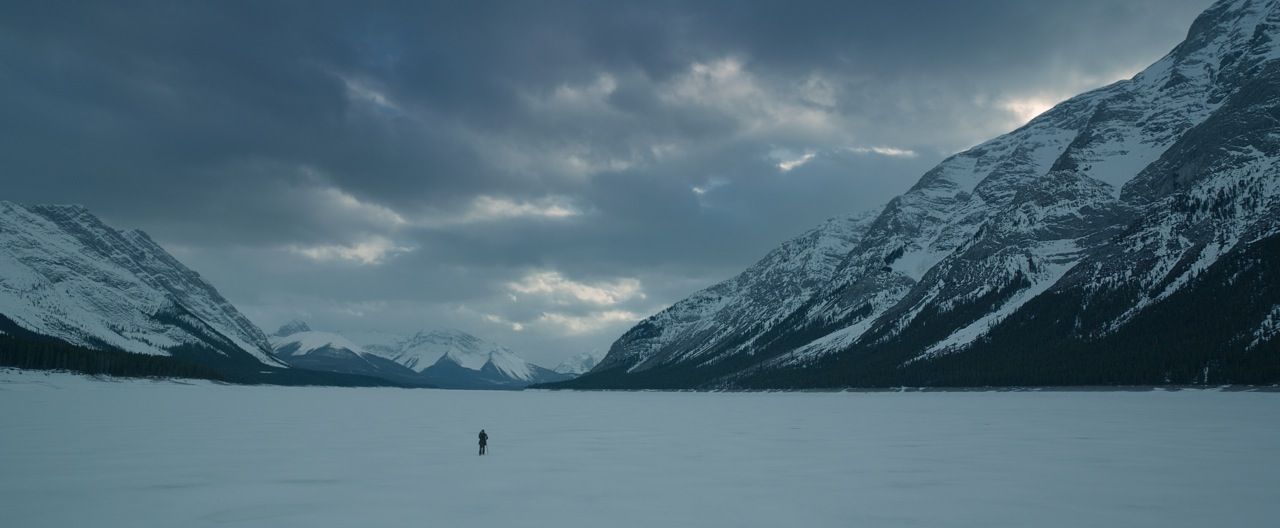The Revenant is a beautiful, haunting, and brutal tale of a man's struggle against nature, himself, and his fellow man. And at the same time, it is one of those brilliantly conceived movies that uses screen time to allow the audience to meditate and reflect on what they have just witnessed. Go see this movie.
How do you describe The Revenant? Is it The Frontiersmen on the silver screen? Is it a revenge story? Is it a meditation on the relationship between man and nature? In many ways, it is all of these, but more than that, it is a celebration of what makes films such a powerful art form. If one has a narrow definition of what a film ought to be, the movie itself is rather easy to encapsulate...if all one wants to consider is the plot. But if one moves beyond that unnecessarily confining view of movies, then The Revenant will come as a welcome and pleasant surprise.
SPOILERS AHEAD...though, the movie's plot is so bare bones that this doesn't matter. The basic plot is thus: Hugh Glass (Leonardo DiCaprio) is mauled by a bear during an expedition with Captain Andrew Henry (Domhnall Gleeson); his son Hawk (Forrest Goodluck); John Fitzgerald (Tom Hardy), a trapper; Jim Bridger (Will Poulter), a young trapper; and several others. Glass is left with Hawk, Jim, and Fitzgerald to ensure he receives a proper burial when he passes away (as the others assume). After a confrontation, Fitzgerald murders Hawk and leaves Glass for dead then returns back to the fort with Jim where Captain Henry is waiting to pay them for their service (for supposedly properly burying Glass). What ensues is Glass's journey back and his search for revenge. He gets his revenge. The End.
Sounds run of the mill? Boring even? Not worthy of an Oscar nomination for Best Picture, a Best Actor nod for Leo, and ten other nominations? Hardly. To describe and judge this movie based on the plot is to show a grave misunderstanding of what films are and can be. There is a several axis spectrum of movies potential goals/motivations, from the amusement ride fun of Transformers to the grandeur of Ben-Hur or the savvy political commentary of Dr. Strangelove. Each serves a particular purpose and satisfies a specific desire. But while those, maybe with the exception of Transformers, all have tight, strong stories that are integral to the enjoyment of the movie, The Revenant is not in that class of film. And it is all the better for it.
There is a scene early in The Revenant right after Hawk dies when Glass is laying over him, breathing and taking in what has just happened. The camera movies close up on Glass and begins to fog as he continues breathing. It's something you don't often seen in a wide release film and the scene is ever more intimate for it. But more than the fogging of the camera is the lingering. Oh the lingering. The camera just keeps running, its focus on the characters plight not giving way to the current tendency to jump cut every scene. Some critics argue about the length of this film, that this is a two and a half hour journey that could be told in a single hour. That might be true. Hell it could probably be told in thirty minutes if you are watching this to get to the final showdown (e.g. every Marvel movie). But you aren't and shouldn't watch this film that way.
The Revenant is meant to be an experience. A cerebral one if you want, but also a sensory one. The lingering shots, those moments when the camera continues to roll and focus on a character or scene are integral to the movie, in the same way that the fast cuts and quip-a-minute are integral to The Avengers and many of Marvel's other films in driving their frantic, superhero-saving-the-day tone. If this film is viewed as a meditation on man's relationship to nature and to himself, then this would be undermined by jump cuts and fanciful editing in that mold. For example, as great as Edge of Tomorrow is, the smooth-as-butter, fast-paced editing there that keeps it from feeling repetitive or stale would have ruined this film because there would have been no time to reflect upon what the audience has seen and to gain a moment to breath.
After the bear attack and once Glass finally kills it, there is a moment when the camera lingers on him and the bear lying there, both seemingly dead. It doesn't immediately cut away to a close-up of the search party either, it lingers and then changes camera angle so you can see the search party slowly come upon Glass and rescue him. This allows the audience to have time to process what just happened and appreciated it. For the bear attack scene was displayed as a single take, up close and personal. This keeps the tension up and brings you right into the experience, but also leaves the audience exhausted and breathless after, needing that moment of rest that the two lingering shots help provide.
In some sense, The Revenant is like two other movies from 2015, The Hateful Eight and Mad Max. The Hateful Eight was a play transformed into a movie while Mad Max had a bare bones story that was more about the sensory experience of the (car) chase than the motivations behind it. However, whereas The Hateful Eight falls a bit short because we end up not caring about any of the characters or events and Mad Max has just enough of a plot that one starts to wonder about some of the decisions each character makes, The Revenant never oversteps its bounds and is laser focused on its singular purpose to recount the rugged, bitter journey of Glass back to civilization.
While watching the film I was expecting to become bored with the movie's slow pace relative to other films. But quite the opposite occurred. I felt keenly aware of enjoying the ride, smiling on the inside, and anticipating what the next scene would bring. The director, Alejandro G. Iñárritu, seemed to have a love of the Scenic Nature Shot as a transition, with several shots consisting of either no humans or just a single man (often Glass) set against a stark, gorgeous landscape. The little cuts, when we are treated to just a group of trees or a river, are great little breathers—moments for the audience to reflect, reorient, and recharge to get ready for the next part of the journey. They reflect Glass's experience and the experience of the frontiersmen, where moments of high adrenaline were punctuated by slower moments in the wilderness.
There is a particular shot where the camera lingers for awhile on a sumptuous shot of a plateau with a river running through it. At first I wondered why?. Why waste precious movie time on a National Geographic style shot that isn't central to the plot. But then as the camera lingers, and my eyes wander around the scene absorbing the wonder of it all, my awe at the beauty of the natural landscape began to swell. These frontiersmen have a tight symbiotic (or parasitic depending on the view point) relationship with nature and yet they are so focused on trapping furs or defending themselves against (or just plain murdering) Native Americans and other dangers that they rarely have time to experience the beauty around them. This is in stark contrast to our current civilization, where people constantly admire the beauty of nature but rarely live it, encounter it face-to-face, or have to deal with its harsh, angry reality. It is a nice little theme and a contrast (between the beauty of the natural landscape and the harsh world that accompanies it) that while maybe not intentional, seems to pervade the movie.
If the film has faults, they lay largely with the portrayal of the Native American's and the other French/English frontiersmen themselves. The frontiersmen are portrayed in the Glass-esque heroic mold or are drunks/rapists (e.g. they've captured the Native American girl and are raping her). The Native Americans are aggrieved about the White Man stealing their land. And the settlers all seem to have a merry time (drinking) at night to wash away the bleakness of living in the frontier. In addition, the very final encounter between Glass and Fitzgerald ends as something of a whimper and it isn't clear how well their actions during those final moments match those of the characters they portray throughout the film. Some might even ask why we don't explore Glass the character in greater depth, ignoring that this would ruin the mystique and distract from the central push of the movie, which was to show his experience getting back. However, the sheer force of Leo's performance and the bleak beauty of the rest of the film overpower these weaknesses.
This film would be even better if they could effectively translate it to virtual reality. The immersion would make this an (entertainment) experience of the highest order. However, given we aren't there yet, the film as it is top grade. The cinematography is the best I've seen for some time, the score is at once haunting and used appropriately (and sparingly at times), the acting is spot on (more so for Leo than the rest of the cast), the script is tight and focused, and the overall experience is something not to miss. Go see The Revenant.
 stanford
stanford linkden
linkden github
github goodreads
goodreads medium
medium twitter
twitter

